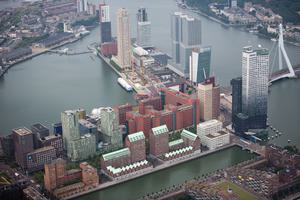Europe
-
With New Tools, A Focus On Urban Methane Leaks
Until recently, little was known about the extent of methane leaking from urban gas distribution pipes and its impact on global warming. But recent advances in detecting this potent greenhouse gas are pushing U.S. states to begin addressing this long-neglected problem.
-
How Ocean Noise Pollution Wreaks Havoc on Marine Life
Marine scientist Christopher Clark has spent his career listening in on what he calls “the song of life” in the world’s oceans. In an interview with Yale Environment 360, he explains how these marine habitats are under assault from extreme—but preventable—noise pollution.
-
Is Climate Change Putting World’s Microbiomes at Risk?
Researchers are only beginning to understand the complexities of the microbes in the earth’s soil and the role they play in fostering healthy ecosystems. Now, climate change is threatening to disrupt these microbes and the key functions they provide.
-
As Electric Cars Stall, A Move To Greener Trucks and Buses
Low gasoline prices and continuing performance issues have slowed the growth of electric car sales. But that has not stymied progress in electrifying larger vehicles, including garbage trucks, city buses, and medium-sized trucks used by freight giants like FedEx.
-
New Green Challenge: How to Grow More Food on Less Land
If the world is to have another Green Revolution to feed its soaring population, it must be far more sustainable than the first one. That means finding ways to boost yields with less fertilizer and rethinking the way food is distributed.
-
Food Insecurity: Arctic Heat Is Threatening Indigenous Life
Subsistence hunters in the Arctic have long taken to the sea ice to hunt seals, whales, and polar bears. But now, as the ice disappears and soaring temperatures alter the life cycles and abundance of their prey, a growing number of indigenous communities are facing food shortages.
-
The Carbon Counters: Tracking Emissions in a Post-Paris World
In the wake of the Paris climate agreement, developing countries find themselves in need of analysts capable of monitoring their emissions. It’s a complex task, but organizations are stepping in with online courses to train these new green accountants.
-
In Istanbul’s Ancient Gardens, A Battle for Future Harvests
Development pressures are threatening Istanbul's centuries-old gardens, which have produced food for the city's markets since Byzantine times. A coalition of gardeners and environmentalists is fighting to preserve them.
-
Moving Beyond the Autobahn: Germany’s New Bike Highways
With the recent opening of a “bike highway,” Germany is taking the lead in Europe by starting to build a network of wide, dedicated bicycle thoroughfares designed to lure increasing numbers of commuters out of their cars and onto two wheels.
-
With Court Action, Obama’s Climate Policies in Jeopardy
The U.S. Supreme Court order blocking President Obama’s plan to cut emissions from coal-burning power plants is an unprecedented step and one of the most environmentally harmful decisions ever made by the nation’s highest court.
-
Aerial Views Of Why Europe Has a Small Carbon Footprint
Europe and the United States have very similar standards of living, but significantly different carbon footprints. Aerial photographer Alex MacLean documents this phenomenon in images that show how Northern Europe uses smart design and planning to reduce the amount of carbon it emits.
-
What’s Causing Deadly Outbreaks of Fungal Diseases in World’s Wildlife?
An unprecedented global wave of virulent fungal infections is decimating whole groups of animals — from salamanders and frogs, to snakes and bats. While scientists are still trying to understand the causes, they are pointing to intercontinental travel, the pet trade, and degraded habitat as likely factors.
-
To Protect Monarch Butterfly, A Plan to Save the Sacred Firs
Mexican scientists are striving to plant oyamel fir trees at higher altitudes in an effort to save the species, as well as its fluttering iconic winter visitor — the migrating monarch butterfly — from the devastating effects of climate change.
-
Turning Point: Landmark Deal On Climate Is Reached in Paris
In what could be a turning point, the world’s nations reached an agreement in Paris that would commit them to cutting emissions and keeping global warming below 2 degrees. Although the pledges are not binding, the deal includes a review process to determine if countries are meeting their commitments.
-
For Storing Electricity, Utilities Are Turning to Pumped Hydro
High-tech batteries may be garnering the headlines. But utilities from Spain to China are increasingly relying on pumped storage hydroelectricity first used in the 1890s to overcome the intermittent nature of wind and solar power.
-
Beyond Keystone: Why Climate Movement Must Keep Heat On
It took a committed coalition and the increasingly harsh reality of climate change to push President Obama to reject the Keystone XL pipeline. But sustained public pressure will now be needed to force politicians to take the next critical actions on climate.
-
The Rapid and Startling Decline Of World’s Vast Boreal Forests
Scientists are becoming increasingly concerned about the fate of the huge boreal forest that spans from Scandinavia to northern Canada. Unprecedented warming in the region is jeopardizing the future of a critical ecosystem that makes up nearly a third of the earth’s forest cover.
-
One Scientist’s Hopeful View On How to Repair the Planet
Ecological crises may be piling up in a seemingly hopeless cascade, but Swedish scientist Johan Rockström says the next few decades offer an unparalleled opportunity to undo the damage.
-
Natura 2000: EU Reserves Are Facing Development Pressures
An astonishing 18 percent of the European Union’s land area is protected under a network of preserves known as Natura 2000. Now, at the urging of business interests and farmers, the EU is examining whether regulations on development in these areas should be loosened.

